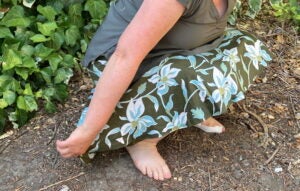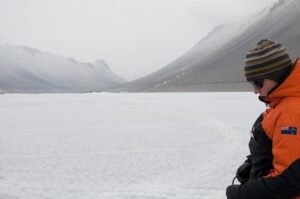Peeing and Pooping in the Field
If you need to pee or poop without a toilet around…
- Don’t be embarrassed. Everyone needs to. It is dangerous not to let your body remove waste – it can cause serious health problems.
- There are many ways to find or create enough privacy to take care of these bodily functions.
- Look for an area behind some bushes, a curve in the outcrop or topography, large rocks, in a gully, etc.
- Ask a friend to be the lookout and stop anyone headed your way to increase your privacy.
- Wear or put on a skirt that extends at least below your knees and has enough width at the bottom that you can pull down your underwear and have the skirt cover your bare bottom as you squat. If you don’t want to wear one while in the field, you can bring a wrap-around skirt or cloth for when you want some privacy.

An example of a skirt providing privacy. - Bring a pop-up privacy shelter that you can carry and quickly put up or take down. Maybe you can arrange to share one with friends.
- Pee funnels can be useful in many circumstances. They go in through the fly of pants/shorts, with the larger funnel part capturing the pee. The narrow part extends out of the clothing, hopefully directing all of the pee out of the clothing. They take practice to use well. There are some tips I found from my Antarctic field seasons here, along with some thoughts on health issues related to urination, menstruation and vaginal infections for long field seasons. Specific pee funnel tips are in the second half of the post. (I don’t use a pee cloth any more. I go for toilet paper, putting it in a ziplock bag. However, there are now well designed pee cloths that some people in our department like to use. I haven’t tried one yet.)
- Sometimes there is just no shelter, and we just have to ask those we are with to face the other direction until we are done.

There is no cover anywhere on an ice-covered, Antarctic lake. We also have to pee in bottles (using pee funnels for some of us) to keep nutrients out of the environment. We ask our team members to give us privacy when we need it.
- If you don’t want to use a pee cloth to dry off after urinating, bring toilet paper or wet wipes, ziplock bags, and a paper bag or other opaque bag. You can use the toilet paper and seal it in a ziplock bag. If you put it in the opaque bag, no one will see the used toilet paper. Washing with water is also an option, one common in many places in the world where toilet paper and wet wipes are not available.
- If you need to poop, here are two options:
- Traditional: Dig a hole that is at least 10 inches deep (to get the nutrients in your poop down into the soil microbe zone). This can be hard in rocky areas. One approach is to dig a narrow trough with a rock hammer. Alternatively, it may be easier to dig a largish rock out of the ground and use the resulting hole. The rock can then be placed over your waste back into its original hole. Be sure to fully cover your waste with close to 10 inches of dirt/rock. It is good to put a pile of rocks on top of your waste if you mostly cover it with dirt to keep animals from digging it up (which does happen, unfortunately). I prefer not to try to bury toilet paper in the field even when I am burying poop. I put it in a ziplock bag because it’s just easier to deal with that way.
- Mountaineer and dog-owner technique: Poop on the ground. Then just to ignore any squeamish qualms, put your hand inside an intact, strong plastic bag, pick up the poop through the bag, invert the bag around the poop, and seal it well. It really isn’t all that bad if you “just do it” and don’t think about it. You can put the poop bag inside another one so it can’t be seen. You can double bag it for extra strength. I use thick dog poop pickup bags for this purpose. See “Poop Happens. What Happens Next?” or my blog post on what we do in Antarctica.
- Don’t use a pee cloth instead of toilet paper or wet wipes for poop (unless it’s an emergency) as it will need to be cleaned before you can use it again.
- Tampons and other sanitary supplies can also be put into ziplock or dog poop bags. They should not be buried because they never decay. Consider how you want or don’t want to use a pee cloth if menstruation is involved.
- Throw away your ziplock bag(s) of waste in a dumpster or garbage bag/can where it will be disposed of without contact by other people. In general, we aren’t supposed to put human waste in the normal garbage. However, there are very few places to dispose of this type of waste, outside of heavily used national parks. Thus, I do put my waste in the normal trash (still well sealed in the ziplock bag) when there aren’t realistic other options. I figure it’s better than leaving it in the environment.
- NEVER put plastic bags in pit toilets. Pit toilets have to be cleaned out by people. When there are items that don’t decay in pit toilets, including plastic, tampons, and pads, it is really disgusting for the poor people who have to deal with it.
Respect in the field…
Please respect others’ privacy when in the field. This includes when someone needs to relieve themselves, when you need to relieve yourself, and when people are changing. Sometimes, you “walk in” on someone or they walk in on you. The proper response is to apologize and leave immediately. In very rare cases (like on the middle of an ice-covered lake in Antarctica), there is no way to provide privacy except to turn ones back. Respect and understanding go a very long ways toward building a supportive, productive environment in the field.